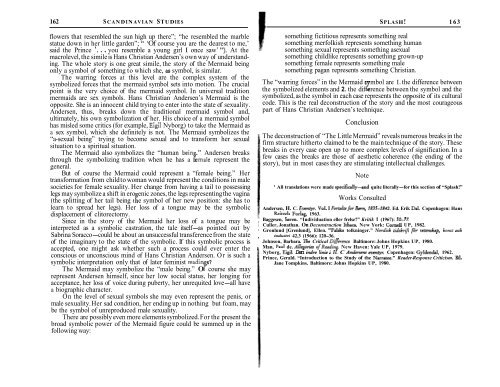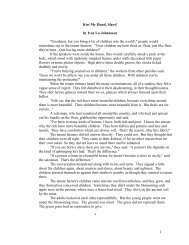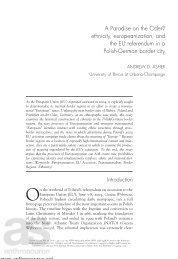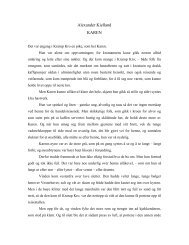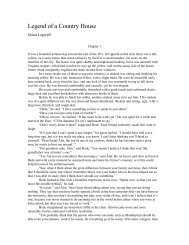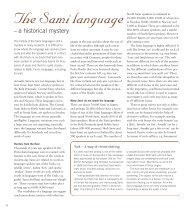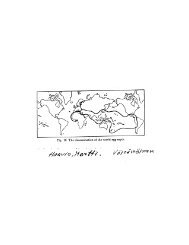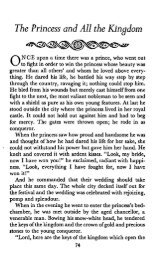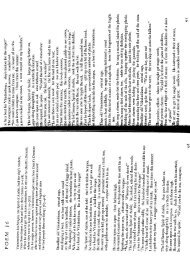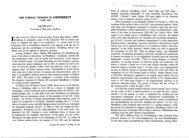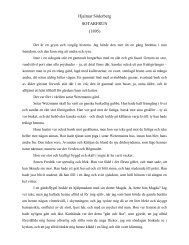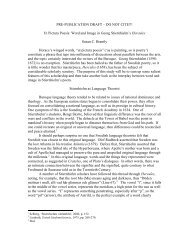Six Views of “The Little Mermaid” - Department of Scandinavian ...
Six Views of “The Little Mermaid” - Department of Scandinavian ...
Six Views of “The Little Mermaid” - Department of Scandinavian ...
You also want an ePaper? Increase the reach of your titles
YUMPU automatically turns print PDFs into web optimized ePapers that Google loves.
162 SCANDINAVIAN STUDIES<br />
flowers that resembled the sun high up there”; “he resembled the marble<br />
statue down in her little garden”; “ ‘Of course you are the dearest to me,’<br />
said the Prince ‘. . . you resemble a young girl I once saw’ ”). At the<br />
macrolevel, the simile is Hans Christian Andersen’s own way <strong>of</strong> understanding.<br />
The whole story is one great simile, the story <strong>of</strong> the Mermaid being<br />
only a symbol <strong>of</strong> something to which she, as symbol, is similar.<br />
The warring forces at this level are the complex system <strong>of</strong> the<br />
symbolized forces that the mermaid symbol sets into motion. The crucial<br />
point is the very choice <strong>of</strong> the mermaid symbol. In universal tradition<br />
mermaids are sex symbols. Hans Christian Andersen’s Mermaid is the<br />
opposite. She is an innocent child trying to enter into the state <strong>of</strong> sexuality.<br />
Andersen, thus, breaks down the traditional mermaid symbol and,<br />
ultimately, his own symbolization <strong>of</strong> her. His choice <strong>of</strong> a mermaid symbol<br />
has misled some critics (for example, Eigil Nyborg) to take the Mermaid as<br />
a sex symbol, which she definitely is not. The Mermaid symbolizes the<br />
“a-sexual being” trying to become sexual and to transform her sexual<br />
situation to a spiritual situation.<br />
The Mermaid also symbolizes the “human bein .” Andersen breaks<br />
through the symbolizing tradition when he has a P emale represent the<br />
general.<br />
But <strong>of</strong> course the Mermaid could represent a “female being.” Her<br />
transformation from child to woman would represent the conditions in male<br />
societies for female sexuality. Her change from having a tail to possessing<br />
legs may symbolize a shift in ero enic zones, the legs representing the vagina<br />
(the splitting <strong>of</strong> her tail being t fl e symbol <strong>of</strong> her new position: she has to<br />
learn to spread her legs). Her loss <strong>of</strong> a tongue may be the symbolic<br />
displacement <strong>of</strong> clitorectomy.<br />
Since in the story <strong>of</strong> the Mermaid her loss <strong>of</strong> a tongue may be<br />
interpreted as a symbolic castration, the tale itself-as pointed out by<br />
Sabrina Soracco-could be about an unsuccessful transference from the state<br />
<strong>of</strong> the imaginary to the state <strong>of</strong> the symbolic. If this symbolic process is<br />
accepted, one might ask whether such a process could ever enter the<br />
conscious or unconscious mind <strong>of</strong> Hans Christian Andersen. Or is such a<br />
symbolic interpretation only that <strong>of</strong> later feminist readin s?<br />
The Mermaid may symbolize the “male being.” 0 H course she may<br />
represent Andersen himself, since her low social status, her longing for<br />
acceptance, her loss <strong>of</strong> voice during puberty, her unrequited love-all have<br />
a biographic character.<br />
On the level <strong>of</strong> sexual symbols she may even represent the penis, or<br />
male sexuality. Her sad condition, her ending up in nothing but foam, may<br />
be the symbol <strong>of</strong> unreproduced male sexuality.<br />
There are possibly even more elements symbolized. For the present the<br />
broad symbolic power <strong>of</strong> the Mermaid figure could be summed up in the<br />
following way:<br />
SPLASH! 163<br />
something fictitious represents something real<br />
something merfolkish represents something human<br />
something sexual represents something asexual<br />
something childlike represents something grown-up<br />
something female represents something male<br />
something pagan represents something Christian.<br />
The “warring forces” in the Mermaid s mbol are 1. the difference between<br />
the symbolized elements and 2. the dif r erence between the symbol and the<br />
symbolized, as the symbol in each case represents the op osite <strong>of</strong> its cultural<br />
code. This is the real deconstruction <strong>of</strong> the story and t hp e most courageous<br />
part <strong>of</strong> Hans Christian Andersen’s technique.<br />
Conclusion<br />
The deconstruction <strong>of</strong> <strong>“The</strong> <strong>Little</strong> <strong>Mermaid”</strong> reveals numerous breaks in the<br />
firm structure hitherto claimed to be the main technique <strong>of</strong> the story. These<br />
breaks in every case open up to more complex levels <strong>of</strong> signification. In a<br />
few cases the breaks are those <strong>of</strong> aesthetic coherence (the ending <strong>of</strong> the<br />
story), but in most cases they are stimulating intellectual challenges.<br />
Note<br />
’ All translations were made specifidly-iand quite literally-for this section <strong>of</strong> “Splash!”<br />
Works Consulted<br />
Andersen, H. C. Eventyr. Vol. I Fortrftefor h, 1835-2842. Ed. Erik Da1. Copenhagen: Hans<br />
Reitzels Forlag, 1963.<br />
Baggesen, Ssren. “Individuation eller frelse?” Kritik 1 (1967): 5577.<br />
Culler, Jonathan. On Deconstruction Ithaca, New York: Cornell UP, 1982.<br />
Gronlund [Grenlund], Ellen. “Falske tolkninger.” Nordisk tidskriji fir wtemkq, konst och<br />
~ industri 42.3 (1966): 120-36.<br />
Johnson, Barbara. Be Critical Daference Baltimore: Johns Hopkins UP, 1980.<br />
Man, Paul de. Ahgories <strong>of</strong>Reading. New Haven: Yale UP, 1979.<br />
Nyborg, Eigil. Den indre hie i H C Andm evmtyr. Copenhagen: Gyldendal, 1962.<br />
Prince, Gerald. “Introduction to the Study <strong>of</strong> the Narrxee.” Reader-Response Criticism. Ed.<br />
Jane Tompkins. Baltimore: Johns Hopkins UP, 1980.


